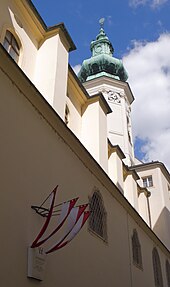Annakirche (Vienna)
The Anna Church is a Roman Catholic religious church in Annagasse 3b in Vienna's 1st district, Inner City, and is considered one of the most beautiful baroque churches in the city.
Next to the church is the St. Anna Hof , a well-known event and residential building. Annagasse , which was formerly called Pippingerstrasse, was named after St. Anna's Church in 1750 ; this street was first named in a document in 1290.
history
In 1415 the Viennese Elisabeth Wartenauer bought the property where small buildings stood on Kärntner Straße 37. With a foundation in 1418 a pilgrim house was built there and a pilgrim hospital was built in Annagasse 3a. A century later, Annakirche was built at Annagasse 3b as a late Gothic four-bay hall church with buttresses and a roof turret over the western gable and inaugurated in 1518. In 1531 the buildings were handed over to the Order of Clarissi as a replacement for their abandonment of the St. Clara Monastery on Albertinaplatz . In 1582 the buildings were handed over to the Jesuits by Rudolf II , who built a new Jesuit novitiate between 1627 and 1629 at Kärntner Strasse 37 at the corner of Annagasse 3 and 3a and Johannesgasse 4 and 4a . From 1629 to 1633 the Anna Church was redesigned in the early Baroque style, with the Gothic choir closure, the roof turrets and the vaults being demolished and the hall building expanded to the west by two yokes in the structure of the novitiate. In addition, chapels were installed between the buttresses, a new vaulting of the hall and the erection of a church tower in the east of the choir with a residential building in the basement. On November 20, 1633, the enlarged church was consecrated in the presence of Emperor Ferdinand II .
In 1694, Leopold I founded a brotherhood to St. Anna , with which behind the hall church a high baroque chapel of St. Franz Xaver was created, which was established in 1709 and is now called Anna Chapel . In 1716, under the direction of Christoph Tausch SJ (1673–1731), the entire church was refurbished. On June 25, 1747, the tower and roof of the church burned down due to lightning. The vaults held up, the roof was poorly restored and so the Anna Festival could be celebrated in the church on July 26th in the presence of Empress Maria Theresa . In 1748 the church tower was rebuilt and in 1751 the smoke-blackened church interior was renovated, whereby Le Grand, as Daniel Gran was called at the time , created the late baroque ceiling frescoes and the high altar picture. 1840 was allowed Grans frescoes by Franz Geyling in darker colors renew.
In 1773 the Jesuit order was abolished. The Anna Church was now looked after by secular clergy and from 1783 masses were held in French. In 1774 the novitiate was rededicated into a school building and was the seat of the Academy of Fine Arts from 1786 to 1876 . This building was in the old St. Annahof .
In 1887 the entire building complex of the St. Anna Court including the two yokes of the former extension of the Anna Church was demolished. Since then, various event and business premises have been located in the new building.
In 1897 the Order of the Oblates of St. Francis de Sales took over the services in the Anna Church and in 1906 the oblates were also given ownership. Since 1908, the Holy of Holies has been exposed every day in St. Anne's Church and the opportunity to confess has been given every day.
The restoration of 1969/70 removed the Geyling overpainting. The restorer was the painter Gustav Krämer, the gilding was done by Mrs. Campitell.
From 2003 to 2005, the Anna Church was renovated under the auspices of the Vienna Federal Monuments Office.
Artist
The names of the artists working here are convincing of the quality of this church: Daniel Gran (1694–1757) created the three ceiling frescoes, the high altar painting and the frescoes in the Franz Xaver Chapel, Anna herself is attributed to Veit Stoss, the side altar paintings come from the Viennese Schmidt , Christoph Tausch is responsible for the interior design.
Others
Since 1930 the boy scout group 15 “St. Anna ”of the boy scouts and girl guides of Austria .
literature
- Dehio Vienna Inner City 2003 , Annakirche and Oblatenkloster, p. 14f.
- Gerhard Schmidt: Christian Art Places Austria , No. 427, Verlag St. Peter, Salzburg 2005
Web links
Remarks
- ↑ The dates given here are based on the report by Richard Perger: On the building history and equipment of the Anna Church in Vienna I , in: Österreichische Zeitschrift für Kunst und Denkmalpflege, XL / 86, pp. 8-19. Perger relies on "Litterae annuae provinciae Austriae Societatis Jesu", the annual reports of the Austrian Jesuit provincials to the Order General in Rome, Austrian National Library .
Coordinates: 48 ° 12 ′ 15.6 ″ N , 16 ° 22 ′ 19.7 ″ E


